Please take a look at the translated interview article with LOST surfboard shaper Matt "MAYHEM" Biolos that was published on the WSL website.
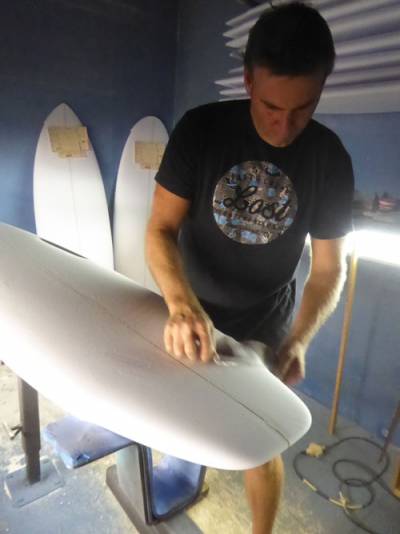 Matt “Mayhem” Biolos has been in the shaping world for nearly 30 years.
Matt “Mayhem” Biolos has been in the shaping world for nearly 30 years.
Bioros started out sanding surfboards under Harvey Fletcher before launching Lost Surfboards, now one of the largest and most recognized surfboard companies in the world. Bioros was convinced that Chris Ward would make him famous, but it wasn't until WSL surfer Strider Wasilewski appeared on the cover with his boat that he became famous. Today's "Mayhem" boards are ridden by a star lineup of surfers including three-time World Champion Carissa Moore, Taylor Wright, the Ho Family, and Kolohe Andino.
Of the 10 women's tour events in 2015, four were won by riders using Bioros-shaped boards. As he evolved over the years, his focus became more and more on marketing and developing his business, which has three facilities in San Clemente: a shaping warehouse, a glass shop, and a quality assurance shaping factory.
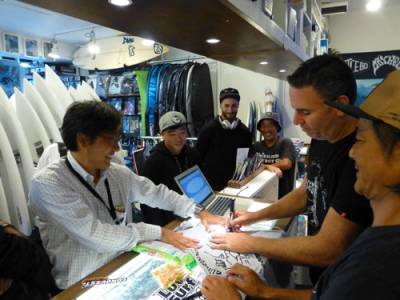 Unlike many of the world's most famous shapers, Biolos still goes into the shaping room, gets his hands dirty, and improves his boards. Ten to fifteen times a year, Biolos finds time to get back to his roots. He also travels to seven countries to take custom orders, visiting local surf shops and talking to local surfers to find the best shapes for their needs. (He's
Unlike many of the world's most famous shapers, Biolos still goes into the shaping room, gets his hands dirty, and improves his boards. Ten to fifteen times a year, Biolos finds time to get back to his roots. He also travels to seven countries to take custom orders, visiting local surf shops and talking to local surfers to find the best shapes for their needs. (He's even come to Japan!)

Daniel Jenks: Can you briefly explain how you create shapes? What are your origins and interests?
Matt Biolos: I'm a typical Southern Californian who grew up in the '80s. I grew up skateboarding and snowboarding. Surfing didn't really interest me until I was 14, in 1983. I surfed throughout high school, but I wasn't competitive like the other surfers around me. For me, surfing was just one of those sports, along with fishing, skateboarding, sailing, and other sports. Surfing was never my sole focus. However, when I was in high school, I got a part-time job at the Dana Point dock, maintaining and cleaning boards, and I spent a lot of time on boats. I enjoyed working on the water, and I began to understand my relationship with the water. Then, a week after graduating from high school, I started working at Herbie Fletcher's shop. It's a job I've never really quit. Herbie was a catalyst in my life, and I've been doing it for 28 or 29 years now.
DJ: How many shapes do you usually do before a surfer comes to you? If they're looking for a particular dimension or feel, how do you translate that into the shape?
MB: Over the years, you start to gain confidence. It wasn't until the Chris Ward, Corey Lopez, and Shane Beschen days that I really started to gain confidence. Around the late '90s, that was when I knew my craft was getting so good and I was on top of it. When you're making boards for some of the best surfers in the world, you start to believe, "I can do this!" and that's when you establish your benchmark. You start to identify what you need in terms of performance, rather than how good the glass finish is.
DJ: When you look back at your career, is there a surfer whose boards you think, "That was yours?"
MB: When I first started working for the Fletcher brothers, Strider came through the Pipe and became famous, but the surfer who really put me on the map was Chris Ward. He was the surfer, without a doubt. He was amazing in videos when he was about 15 years old.
DJ: I think you were one of the first people to focus on CL as a key element in shaping boards for each surfer.
MB: The first person I met was someone who designed surfboard CAD (Computer Aided Design), and he taught me to focus on volume.
DJ: What did you discover? What did you develop?
MB: It started with learning about bodyweight ratios. In the early 2000s, I had an educated discussion with Siey Lopez, who was in the top 10 at the time. He was one of my best friends at the time, and he looked at my board and said, "You've got a fat monster on your board, it looks like a boat." I replied, "Well, you're a 150-pound pro athlete, six to eight years younger than me, and I'm 210 pounds, an average surfer, older than you. I also surf, but in crowds. You're in one-on-one heats." Siey Lopez rode a board that was about 27 liters. I was about 36 liters. If you could do the math, you'd see that our bodyweight ratios were the same. Siey Lopez is so smart, he's now a shaper. Then Mike Price at Firewire started putting volume on his stock boards. I was reviewing the volumes of all the team riders, and he had already finished writing them on the stock board, and when I saw that, I said, "Wow! That's great. I'll do that too."
DJ: What do you consider to be one of your greatest successes?
MB: Back in the day, it was Round Nose Fish. I think the Round Nose Fish
5'5" RNF-VIDEO really put us on the map. We still remember it. It was also great to work with some of the top surfers on the World Tour. Kolohe's rise to the Top 34 a few years ago was amazing.
DJ: Obviously boards are becoming more and more sophisticated, and top surfers go through 60-70 boards a year. What are some things that they have a hard time figuring out what they like and what they don't like?

MB: That's a very difficult point. There are a few people who are always attacking things from the sidelines, like Channel Islands and JS, and Darren Handley. I think my biggest problem is being too single-minded. Dino Andino was one of the people who made me that single-minded. Dino is Mr. Frankenstein. He's a very serious guy, and the feedback he gives me is incredible. He makes the patterns and life I design very complicated. But his feedback is very reliable, and I trust him, and he's the standard by which I judge everything.
His son, Kolohe, is a keen competitor, no matter what people say. That's a rare breed among California surfers. He's a dog-eat-dog type. If you look at the legends of California surfing, he's right up there with Phil Edwards, Mickey Dora, Tom Curren, or Dan Reynolds.
DJ: When you look at these people, what box do you think they fit into?
Why do you see the culture in California that way?
MB: Well, there are two points. First, on a positive note, there's a very deep history and culture. We grew up in the Southern California surf culture lifestyle: the style, the point breaks, the real surfing. California surfing has really shifted into fashion in the last four years. Surfing wasn't just a sport in the '60s, '70s, '80s, even '90s. After Kelly Slater came along, money started flowing. Surfing became more of a sport. But if you look at Australia, surfing has been a competitive sport since the beginning. They had club competitions, lifesaving competitions, paddleboard competitions, and all that. Surfing in Brazil was really a sport. In California, it was just surfers competing against each other. There weren't many professional surfers in California in the '70s and '80s.
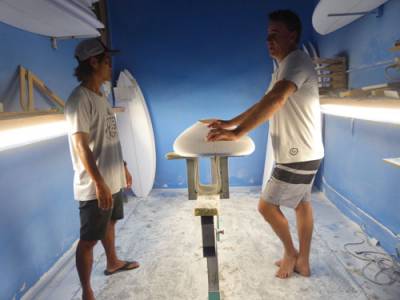
DJ: The best part is when you're designing the form of a shape.
What excites you most?
MB: When I'm thinking of new ideas, new curves, new rockers, new designs, anything new. That's when the switch flips. I don't want to make the same boards all the time.
DJ: Do you have mixed feelings when everyone is riding your board, or when you're the world's top custom-ordered board? Do you feel like you don't have enough time to enjoy it?
MB: I make my own time. If I think about why my brand is different from other brands, I think it's because I make my own time. I used to be in charge of about six people on the World Tour, and I had to build boards for every competition for them. I couldn't keep it up, and I lost Julian and Brett Simpson. I couldn't focus solely on them. Because I also wanted to do my own thing. Like, I wanted to go skiing and snowboarding with my family at Mammoth Mountain in California for a few days. I didn't have time to do everything. I wanted to make fun boards that people would enjoy, and I wanted to surf them myself. I'm a California guy. I'm not Darren Handley. They're just competitive animals, but I'm not. I'm a different type of person. I prefer to work with my own team. I feel better when I'm working with guys like Chris Ward and Corey Lopez.
DJ: Do you ever borrow ideas from other shapers?
MB: Not in terms of design. Business-wise, we have a very transparent relationship where we exchange information with each other. I work closely with many shapers, including the Australian shapers, MR, Handley, and American T. Patterson. We mostly talk about how hard the business is, or about materials, quality, and managing expenses. We have a mutual respect for each other. There is someone I've been talking to a lot about design for years, and that is Johnny Cabianca, Gabriel Medina's shaper. Johnny and I are very good friends and spend many hours together. We always sit in front of the computer and enjoy that time together. Johnny is one of the most underrated people and shapers right now, just like T. Patterson, who is also underrated.

Matt Biolos: At his San Clemente glass factory, Biolos uses an AKU-SHAPER. He cuts the glass frame for about 20-30 minutes before hand-shaping for about an hour.
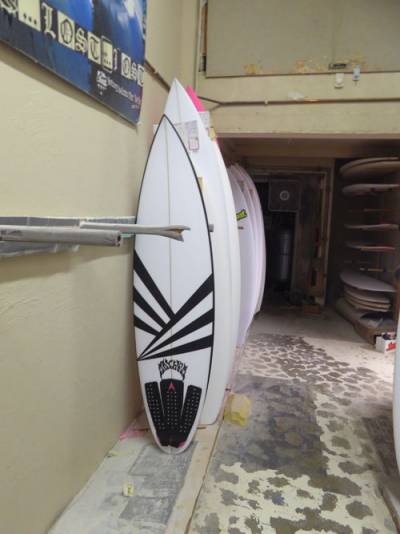
-Pocket Rocket, a new model from Bioros.
Artwork design by Kolohe Andino.
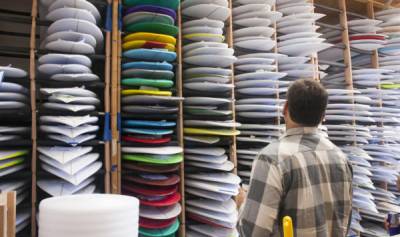
- Matt Biolos checks the warehouse where boards are stored as they become available for shipping.
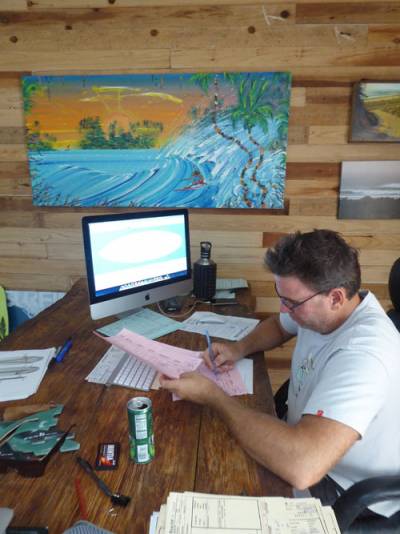
-Matt Biolos will be releasing several new models in the coming months.
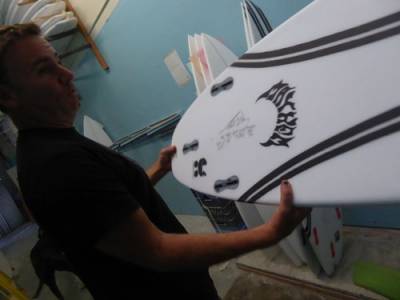
One of them is the new carbon wrap.
Be sure to check out Matt Biolos' board action at the 2016 Championship Tour kickoff in March on Australia's Gold Coast! Matt “Mayhem” Biolos has been in the shaping world for nearly 30 years.
Bioros started out sanding surfboards under Harvey Fletcher before launching Lost Surfboards, now one of the largest and most recognized surfboard companies in the world. Bioros was convinced that Chris Ward would make him famous, but it wasn't until WSL surfer Strider Wasilewski appeared on the cover with his boat that he became famous. Today's "Mayhem" boards are ridden by a star lineup of surfers including three-time World Champion Carissa Moore, Taylor Wright, the Ho Family, and Kolohe Andino.
Of the 10 women's tour events in 2015, four were won by riders using Bioros-shaped boards. As he evolved over the years, his focus became more and more on marketing and developing his business, which has three facilities in San Clemente: a shaping warehouse, a glass shop, and a quality assurance shaping factory.
Matt “Mayhem” Biolos has been in the shaping world for nearly 30 years.
Bioros started out sanding surfboards under Harvey Fletcher before launching Lost Surfboards, now one of the largest and most recognized surfboard companies in the world. Bioros was convinced that Chris Ward would make him famous, but it wasn't until WSL surfer Strider Wasilewski appeared on the cover with his boat that he became famous. Today's "Mayhem" boards are ridden by a star lineup of surfers including three-time World Champion Carissa Moore, Taylor Wright, the Ho Family, and Kolohe Andino.
Of the 10 women's tour events in 2015, four were won by riders using Bioros-shaped boards. As he evolved over the years, his focus became more and more on marketing and developing his business, which has three facilities in San Clemente: a shaping warehouse, a glass shop, and a quality assurance shaping factory.
 Unlike many of the world's most famous shapers, Biolos still goes into the shaping room, gets his hands dirty, and improves his boards. Ten to fifteen times a year, Biolos finds time to get back to his roots. He also travels to seven countries to take custom orders, visiting local surf shops and talking to local surfers to find the best shapes for their needs. (He's even come to Japan!)
Unlike many of the world's most famous shapers, Biolos still goes into the shaping room, gets his hands dirty, and improves his boards. Ten to fifteen times a year, Biolos finds time to get back to his roots. He also travels to seven countries to take custom orders, visiting local surf shops and talking to local surfers to find the best shapes for their needs. (He's even come to Japan!)
 Daniel Jenks: Can you briefly explain how you create shapes? What are your origins and interests?
Matt Biolos: I'm a typical Southern Californian who grew up in the '80s. I grew up skateboarding and snowboarding. Surfing didn't really interest me until I was 14, in 1983. I surfed throughout high school, but I wasn't competitive like the other surfers around me. For me, surfing was just one of those sports, along with fishing, skateboarding, sailing, and other sports. Surfing was never my sole focus. However, when I was in high school, I got a part-time job at the Dana Point dock, maintaining and cleaning boards, and I spent a lot of time on boats. I enjoyed working on the water, and I began to understand my relationship with the water. Then, a week after graduating from high school, I started working at Herbie Fletcher's shop. It's a job I've never really quit. Herbie was a catalyst in my life, and I've been doing it for 28 or 29 years now.
DJ: How many shapes do you usually do before a surfer comes to you? If they're looking for a particular dimension or feel, how do you translate that into the shape?
MB: Over the years, you start to gain confidence. It wasn't until the Chris Ward, Corey Lopez, and Shane Beschen days that I really started to gain confidence. Around the late '90s, that was when I knew my craft was getting so good and I was on top of it. When you're making boards for some of the best surfers in the world, you start to believe, "I can do this!" and that's when you establish your benchmark. You start to identify what you need in terms of performance, rather than how good the glass finish is.
DJ: When you look back at your career, is there a surfer whose boards you think, "That was yours?"
MB: When I first started working for the Fletcher brothers, Strider came through the Pipe and became famous, but the surfer who really put me on the map was Chris Ward. He was the surfer, without a doubt. He was amazing in videos when he was about 15 years old.
DJ: I think you were one of the first people to focus on CL as a key element in shaping boards for each surfer.
MB: The first person I met was someone who designed surfboard CAD (Computer Aided Design), and he taught me to focus on volume.
DJ: What did you discover? What did you develop?
MB: It started with learning about bodyweight ratios. In the early 2000s, I had an educated discussion with Siey Lopez, who was in the top 10 at the time. He was one of my best friends at the time, and he looked at my board and said, "You've got a fat monster on your board, it looks like a boat." I replied, "Well, you're a 150-pound pro athlete, six to eight years younger than me, and I'm 210 pounds, an average surfer, older than you. I also surf, but in crowds. You're in one-on-one heats." Siey Lopez rode a board that was about 27 liters. I was about 36 liters. If you could do the math, you'd see that our bodyweight ratios were the same. Siey Lopez is so smart, he's now a shaper. Then Mike Price at Firewire started putting volume on his stock boards. I was reviewing the volumes of all the team riders, and he had already finished writing them on the stock board, and when I saw that, I said, "Wow! That's great. I'll do that too."
DJ: What do you consider to be one of your greatest successes?
MB: Back in the day, it was Round Nose Fish. I think the Round Nose Fish 5'5" RNF-VIDEO really put us on the map. We still remember it. It was also great to work with some of the top surfers on the World Tour. Kolohe's rise to the Top 34 a few years ago was amazing.
DJ: Obviously boards are becoming more and more sophisticated, and top surfers go through 60-70 boards a year. What are some things that they have a hard time figuring out what they like and what they don't like?
Daniel Jenks: Can you briefly explain how you create shapes? What are your origins and interests?
Matt Biolos: I'm a typical Southern Californian who grew up in the '80s. I grew up skateboarding and snowboarding. Surfing didn't really interest me until I was 14, in 1983. I surfed throughout high school, but I wasn't competitive like the other surfers around me. For me, surfing was just one of those sports, along with fishing, skateboarding, sailing, and other sports. Surfing was never my sole focus. However, when I was in high school, I got a part-time job at the Dana Point dock, maintaining and cleaning boards, and I spent a lot of time on boats. I enjoyed working on the water, and I began to understand my relationship with the water. Then, a week after graduating from high school, I started working at Herbie Fletcher's shop. It's a job I've never really quit. Herbie was a catalyst in my life, and I've been doing it for 28 or 29 years now.
DJ: How many shapes do you usually do before a surfer comes to you? If they're looking for a particular dimension or feel, how do you translate that into the shape?
MB: Over the years, you start to gain confidence. It wasn't until the Chris Ward, Corey Lopez, and Shane Beschen days that I really started to gain confidence. Around the late '90s, that was when I knew my craft was getting so good and I was on top of it. When you're making boards for some of the best surfers in the world, you start to believe, "I can do this!" and that's when you establish your benchmark. You start to identify what you need in terms of performance, rather than how good the glass finish is.
DJ: When you look back at your career, is there a surfer whose boards you think, "That was yours?"
MB: When I first started working for the Fletcher brothers, Strider came through the Pipe and became famous, but the surfer who really put me on the map was Chris Ward. He was the surfer, without a doubt. He was amazing in videos when he was about 15 years old.
DJ: I think you were one of the first people to focus on CL as a key element in shaping boards for each surfer.
MB: The first person I met was someone who designed surfboard CAD (Computer Aided Design), and he taught me to focus on volume.
DJ: What did you discover? What did you develop?
MB: It started with learning about bodyweight ratios. In the early 2000s, I had an educated discussion with Siey Lopez, who was in the top 10 at the time. He was one of my best friends at the time, and he looked at my board and said, "You've got a fat monster on your board, it looks like a boat." I replied, "Well, you're a 150-pound pro athlete, six to eight years younger than me, and I'm 210 pounds, an average surfer, older than you. I also surf, but in crowds. You're in one-on-one heats." Siey Lopez rode a board that was about 27 liters. I was about 36 liters. If you could do the math, you'd see that our bodyweight ratios were the same. Siey Lopez is so smart, he's now a shaper. Then Mike Price at Firewire started putting volume on his stock boards. I was reviewing the volumes of all the team riders, and he had already finished writing them on the stock board, and when I saw that, I said, "Wow! That's great. I'll do that too."
DJ: What do you consider to be one of your greatest successes?
MB: Back in the day, it was Round Nose Fish. I think the Round Nose Fish 5'5" RNF-VIDEO really put us on the map. We still remember it. It was also great to work with some of the top surfers on the World Tour. Kolohe's rise to the Top 34 a few years ago was amazing.
DJ: Obviously boards are becoming more and more sophisticated, and top surfers go through 60-70 boards a year. What are some things that they have a hard time figuring out what they like and what they don't like?
 MB: That's a very difficult point. There are a few people who are always attacking things from the sidelines, like Channel Islands and JS, and Darren Handley. I think my biggest problem is being too single-minded. Dino Andino was one of the people who made me that single-minded. Dino is Mr. Frankenstein. He's a very serious guy, and the feedback he gives me is incredible. He makes the patterns and life I design very complicated. But his feedback is very reliable, and I trust him, and he's the standard by which I judge everything.
His son, Kolohe, is a keen competitor, no matter what people say. That's a rare breed among California surfers. He's a dog-eat-dog type. If you look at the legends of California surfing, he's right up there with Phil Edwards, Mickey Dora, Tom Curren, or Dan Reynolds.
DJ: When you look at these people, what box do you think they fit into?
Why do you see the culture in California that way?
MB: Well, there are two points. First, on a positive note, there's a very deep history and culture. We grew up in the Southern California surf culture lifestyle: the style, the point breaks, the real surfing. California surfing has really shifted into fashion in the last four years. Surfing wasn't just a sport in the '60s, '70s, '80s, even '90s. After Kelly Slater came along, money started flowing. Surfing became more of a sport. But if you look at Australia, surfing has been a competitive sport since the beginning. They had club competitions, lifesaving competitions, paddleboard competitions, and all that. Surfing in Brazil was really a sport. In California, it was just surfers competing against each other. There weren't many professional surfers in California in the '70s and '80s.
MB: That's a very difficult point. There are a few people who are always attacking things from the sidelines, like Channel Islands and JS, and Darren Handley. I think my biggest problem is being too single-minded. Dino Andino was one of the people who made me that single-minded. Dino is Mr. Frankenstein. He's a very serious guy, and the feedback he gives me is incredible. He makes the patterns and life I design very complicated. But his feedback is very reliable, and I trust him, and he's the standard by which I judge everything.
His son, Kolohe, is a keen competitor, no matter what people say. That's a rare breed among California surfers. He's a dog-eat-dog type. If you look at the legends of California surfing, he's right up there with Phil Edwards, Mickey Dora, Tom Curren, or Dan Reynolds.
DJ: When you look at these people, what box do you think they fit into?
Why do you see the culture in California that way?
MB: Well, there are two points. First, on a positive note, there's a very deep history and culture. We grew up in the Southern California surf culture lifestyle: the style, the point breaks, the real surfing. California surfing has really shifted into fashion in the last four years. Surfing wasn't just a sport in the '60s, '70s, '80s, even '90s. After Kelly Slater came along, money started flowing. Surfing became more of a sport. But if you look at Australia, surfing has been a competitive sport since the beginning. They had club competitions, lifesaving competitions, paddleboard competitions, and all that. Surfing in Brazil was really a sport. In California, it was just surfers competing against each other. There weren't many professional surfers in California in the '70s and '80s.
 DJ: The best part is when you're designing the form of a shape.
What excites you most?
MB: When I'm thinking of new ideas, new curves, new rockers, new designs, anything new. That's when the switch flips. I don't want to make the same boards all the time.
DJ: Do you have mixed feelings when everyone is riding your board, or when you're the world's top custom-ordered board? Do you feel like you don't have enough time to enjoy it?
MB: I make my own time. If I think about why my brand is different from other brands, I think it's because I make my own time. I used to be in charge of about six people on the World Tour, and I had to build boards for every competition for them. I couldn't keep it up, and I lost Julian and Brett Simpson. I couldn't focus solely on them. Because I also wanted to do my own thing. Like, I wanted to go skiing and snowboarding with my family at Mammoth Mountain in California for a few days. I didn't have time to do everything. I wanted to make fun boards that people would enjoy, and I wanted to surf them myself. I'm a California guy. I'm not Darren Handley. They're just competitive animals, but I'm not. I'm a different type of person. I prefer to work with my own team. I feel better when I'm working with guys like Chris Ward and Corey Lopez.
DJ: Do you ever borrow ideas from other shapers?
MB: Not in terms of design. Business-wise, we have a very transparent relationship where we exchange information with each other. I work closely with many shapers, including the Australian shapers, MR, Handley, and American T. Patterson. We mostly talk about how hard the business is, or about materials, quality, and managing expenses. We have a mutual respect for each other. There is someone I've been talking to a lot about design for years, and that is Johnny Cabianca, Gabriel Medina's shaper. Johnny and I are very good friends and spend many hours together. We always sit in front of the computer and enjoy that time together. Johnny is one of the most underrated people and shapers right now, just like T. Patterson, who is also underrated.
DJ: The best part is when you're designing the form of a shape.
What excites you most?
MB: When I'm thinking of new ideas, new curves, new rockers, new designs, anything new. That's when the switch flips. I don't want to make the same boards all the time.
DJ: Do you have mixed feelings when everyone is riding your board, or when you're the world's top custom-ordered board? Do you feel like you don't have enough time to enjoy it?
MB: I make my own time. If I think about why my brand is different from other brands, I think it's because I make my own time. I used to be in charge of about six people on the World Tour, and I had to build boards for every competition for them. I couldn't keep it up, and I lost Julian and Brett Simpson. I couldn't focus solely on them. Because I also wanted to do my own thing. Like, I wanted to go skiing and snowboarding with my family at Mammoth Mountain in California for a few days. I didn't have time to do everything. I wanted to make fun boards that people would enjoy, and I wanted to surf them myself. I'm a California guy. I'm not Darren Handley. They're just competitive animals, but I'm not. I'm a different type of person. I prefer to work with my own team. I feel better when I'm working with guys like Chris Ward and Corey Lopez.
DJ: Do you ever borrow ideas from other shapers?
MB: Not in terms of design. Business-wise, we have a very transparent relationship where we exchange information with each other. I work closely with many shapers, including the Australian shapers, MR, Handley, and American T. Patterson. We mostly talk about how hard the business is, or about materials, quality, and managing expenses. We have a mutual respect for each other. There is someone I've been talking to a lot about design for years, and that is Johnny Cabianca, Gabriel Medina's shaper. Johnny and I are very good friends and spend many hours together. We always sit in front of the computer and enjoy that time together. Johnny is one of the most underrated people and shapers right now, just like T. Patterson, who is also underrated.
 Matt Biolos: At his San Clemente glass factory, Biolos uses an AKU-SHAPER. He cuts the glass frame for about 20-30 minutes before hand-shaping for about an hour.
Matt Biolos: At his San Clemente glass factory, Biolos uses an AKU-SHAPER. He cuts the glass frame for about 20-30 minutes before hand-shaping for about an hour.
 -Pocket Rocket, a new model from Bioros.
Artwork design by Kolohe Andino.
-Pocket Rocket, a new model from Bioros.
Artwork design by Kolohe Andino.
 - Matt Biolos checks the warehouse where boards are stored as they become available for shipping.
- Matt Biolos checks the warehouse where boards are stored as they become available for shipping.
 -Matt Biolos will be releasing several new models in the coming months.
-Matt Biolos will be releasing several new models in the coming months.
 One of them is the new carbon wrap.
Be sure to check out Matt Biolos' board action at the 2016 Championship Tour kickoff in March on Australia's Gold Coast!
One of them is the new carbon wrap.
Be sure to check out Matt Biolos' board action at the 2016 Championship Tour kickoff in March on Australia's Gold Coast!




